 Benjamin Piazza
Benjamin PiazzaHome Institution: Pennsylvania State University
Status: Sophomore, Expected Graduation Date: May 2020
Field of Study: Physics with a Minor in Japanese
Host Lab in Japan: Chiba University – Division of Nanomaterial Science, Aoki Laboratory
Host Professor: Prof. Nobuyuki Aoki
Research Abstract and Poster: CVD Graphene Nanoribbons by Silver Nanowire Shadowmasking (PDF)
Why Nakatani RIES?
More than anything else, I am passionate about physics and the Japanese language and in the Nakatani RIES program, I will have the opportunity to develop both of these interests. Nakatani RIES offers the opportunity to perform research in an outstanding selection of laboratories while also emphasizing study of Japanese language and culture.
I am seriously considering applying to doctoral programs in physics in Japan after graduation, and Nakatani RIES will show me what research in a Japanese laboratory is like. I also look forward to working with faculty and graduate students in Japan, which will surely improve my Japanese communication skills. I feel so fortunate to have found in Nakatani RIES a program that so perfectly combines my two main interests and I plan to make the most of my experience this summer.
Goals for the Summer
- Develop proficiency in techniques in experimental physics that I can apply to my thesis research
- Improve Japanese language skills, especially conversation
- See what Japanese graduate education and research labs are like compared to the U.S.
- Have my fortune told at a Shinto shrine
Research Project Overview
My research project had me investigating a novel method (using silver nanowires) of fabricating graphene nanoribbons. It was a fabrication heavy project and had me working with a wide variety of tools. While I am a physics major, I think that materials science is an interesting field that I am now considering for graduate school thanks to this experience. Furthermore, my research this summer has taught me a wide variety of experimental techniques I can back to my research in the United States. As a physics/Japanese double major, I have also been considering going to graduate school in Japan, and this program showed me that that might be right path for me.
The lab that I worked in (Aoki Group) was different from most Japanese labs. While people sometimes work overnight, generally people work a standard eight-hour workday. Researchers are granted a lot of freedom in the group, but weekly group meetings are used to make sure everyone stays on track. This is probably one of the more social labs and people generally know each other well. I did practically everything together with my mentor, Aoki Kensuke. The handholding is necessary though when you consider how many devices you need to work with daily. I appreciated the more laid-back atmosphere of this lab as it let me get socially integrated with the group.
Daily Life in Chiba
Inage was a wonderful place to live for my research internship. Chiba generally has great food, and Inage has an extraordinary array of options to choose from. From Inage, it’s only about an hour to anywhere in Tokyo, which really opens up options for the weekend. I think the only downside to living in Inage was that there weren’t many things to do or see on the weekdays. It’s for that reason that I joined the table tennis club at Chiba University. There I was able to improve my Japanese communication skills and have a fun time with a new sport. I think that for people in the Chiba area, joining a club for the weekdays and traveling on the weekends is probably the right way to do things. I enjoyed my daily life here.
Experiences with Japanese Culture
My favorite experience with Japanese culture was probably seeing the giant Buddha on Mt. Nokogiriyama. I barely gave myself enough time for the trip but seeing that giant statue at the top made the entire experience worth it. This was the first big sightseeing trip I’ve gone on on my own, and it tested me mentally and physically. Getting there was quite a challenge as I had to use my Japanese skills to find my way around as the area around the mountain does not properly show up in Google Maps. Even taking the cable car to the top, I still had to hike for around an hour before I could finally get to the statue. All in all, it was a great experience that showed me I’m capable of making difficult sightseeing trips on my own. The next time I go abroad, I’ll try to do the same thing then. The other remarkable thing was that the entire temple complex was clean, most likely due to regular sweeping. It’s a huge area, and looking back, it was a great example of the Japanese work ethic.
- My favorite experience in Japan was … playing pachinko for the first time. Even with a solid Japanese background, the game is still extremely difficult to play, but that challenge makes it exciting. You need to find the right parlor, get earplugs, spend a few hours figuring out how the machines work, and figure out how to collect your prizes. It was the most challenging experience I had with my Japanese and fun once I got the hang of it. It’s something I wouldn’t do more than once, but at the same time I feel everyone should at least try it out.
- Before I left for Japan I wish I had … studied more Japanese. This may seem odd coming from someone with two years’ worth of Japanese background, but more Japanese is always helpful. I understood enough Japanese to follow my science lectures in Japanese and read most things, but I felt that if I had practiced a bit more before coming here I could have gotten socially involved with my lab group earlier. To be a bit more precise, I wish I had started Wanikani sooner. Wanikani is a fantastic kanji review app that massively expanded my vocabulary, so it gets my full recommendation. It’s a bit expensive, but all you need to start with it is hiragana/katakana.
- While I was in Japan I wish I could have …. seen more historical sites. I saw a fair bit of these early on, but some of the later weekends got busy and there were a few things I wish I had pushed myself to find time to see. My biggest regret would be not seeing very much in Kyoto. If your host lab isn’t near Kyoto, the mid-program meeting will be your only chance to see a lot of famous places there, so you really want to make the most of that.
Excerpts from Benjamin’s Weekly Reports
- Week 01: Arrival in Japan
- Week 02: Language Learning & Trip to Mt. Fuji Lakes
- Week 03: Noticing Similarities, Noticing Differences
- Week 04: First Week at Research Lab
- Week 05: Cultural Analysis – Life in Japan
- Week 06: Cultural Analysis – In the Lab
- Week 07-08: Overview of Mid-Program Meeting & Research Host Lab Visit
- Week 09: Research in Japan vs. Research in the U.S.
- Week 10: Reflections on Japanese Language Learning
- Week 11: Interview with a Japanese Researcher
- Week 12-13: Final Week at Research Lab & Re-Entry Program
- Final Research Overview and Poster
- Follow-on Project
- Tips for Future Participants
Week 01: Arrival in Japan
The pre-departure orientation was useful. For me, hearing about where to go for different services in Tokyo was the best part. The convenient stores in Japan are remarkably convenient and I’ve already used them for meals, retrieving money, and even printing. The hundred-yen store has a huge variety of necessities all at low prices. And the vending machines are so prevalent and have so much options that it’s easy to get whatever I want whenever I want it. Hearing about all this in advance did a lot to ease me in to the culture.
As for Tokyo itself, I didn’t find it too strange at first. I think people overemphasized how different it would be so I ended up finding it a lot more normal than I expected. Almost every cultural difference I’ve run into so far I can personally accept. For example, the idea that you can’t eat while commuting is quite different sure, but it keeps the streets clean so I can accept it. The only thing I haven’t been able to wrap my head around yet is the pachinko parlors. Those have deafening, jet engine level noise and I am very confused how people manage to tolerate it.
The language classes have been a blast so far. I was placed at the 4th level class and I enjoy the flexible structure of the class. There’s traditional textbook work sure, but a lot of the class is just talking in Japanese or reading papers from our respective labs. I am learning a lot of scientific vocab which will be useful for reading physics papers in Japanese if I’m feeling ambitious enough. All of my extensive kanji reviewing feels like it has paid off, both in the language class and reading things in Japan. So long as I keep reviewing kanji and maintain my daily reading regimen I should be able to steadily improve over my stay in Japan.
Of the activities in the first week program, my favorite was the visit to the archaeological sites in Takasaki. Last semester I took a class on the art history of south American cultural groups. Over my visit in Takasaki, I found many parallels between ancient Japan and Moche culture. Both had labor taxation, naturalistic clay forms, ritual mound structures, and water deity worship. What’s especially interesting is that these groups were approximately contemporary to each other. Despite a total lack of communication between these groups they were approximately identical in terms of structure and I found that incredibly fascinating.
I also enjoyed the laboratory tour at Tokyo University. The Tabata Lab we visited had a remarkable assortment of equipment and I found myself impressed at nearly every device. The highlight to me was the clean room, which had a section with no greater than one part per million bacteria in the air. I also really enjoyed the open discussion afterwards. Using my Japanese, I was able to talk to Tokyo University students about their university, Japanese culture, and even what sorts of games they play. I discovered that the professor there plays some of the games I do and we had a lengthy discussion about those. It was great practice for my Japanese and indicates to me I shouldn’t have too many issues integrating with my host lab.

The highlight for me though was seeing the Sanja Matsuri in Asakusa. There were a lot of street vendors there and I tried many varieties of festival food. There were various sizes of Mikoshi and I had fun walking around with those. There were also musical performances scattered around the city. But my favorite part was without a doubt seeing the whole shrine complex. The tower gate was imposing and I don’t think I ever got a proper scale for it in Japanese class. I saw a pagoda for the first time and I was in awe of height and beauty of the structure. The main shrine was beautiful and the murals on the ceiling were a welcome surprise. After seeing this I feel I have a much better sense of Japanese festival and religious culture.
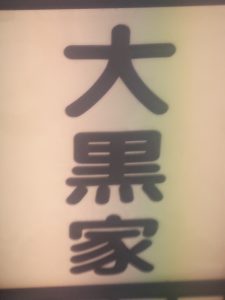
Question of the Week
Besides the earlier question about pachinko parlors, I am curious why the Japanese will sometimes use katakana for Japanese words. I can understand kanji sometimes being used for katakana words like with tabaco, but I don’t understand why some very Japanese words (like the Asian black bear) are sometimes written in katakana. This week I’ll ask my Japanese professors and hopefully gain some insight on that.
Research Host Lab Overview
I believe the goal of my project is relatively straightforward. Currently, the Aoki Group seeks to utilize graphene in logic electronics. To make graphene exhibit semi-conductive properties and function as a logic switch, a band gap is necessary. Graphene is known to lack a band gap, but through various experimental techniques we can artificially induce one. One way is to apply a large perpendicular electric field to the material. This works but restricts us to just bi-layer graphene structures. Another way would be to fabricate nanoribbons of graphene. For a nanoribbon of graphene, the band gap is inversely proportional to the width of the ribbon. According to Aoki-sensei, the current limit on the width of these ribbons is 10 nanometers. He claims that by utilizing scanning gate microscopy, these wires can be fabricated on a much smaller scale, although he does not wish to discuss the details of this method until I arrive at Chiba.
Week 02: Language Learning and Trip to Mt. Fuji Lakes
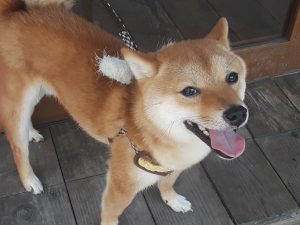
At the end of last semester, I completed my fourth semester of Japanese. Now that I am in Japan I have been trying to use the language whenever I can. Just a few days ago I went to the barber shop and was able to request a specific hairstyle. Furthermore, I was able to chat with my barber for the full duration of the haircut. All in all, I am very happy with my level of proficiency in the Japanese language. If I have the opportunity though, I would like to try initiating more conversations. While I can hold I conversation well for everyday occurrences like buying food or requesting a service, I have yet to have a lengthy conversation in Japanese that has not been facilitated by something or someone. I’m sure going to my lab will help with this, but even still I would like to try just talking with someone before I head off for that.
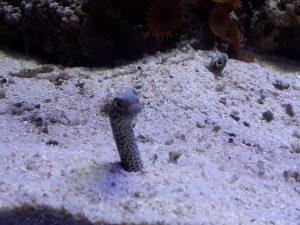
At the end of another week of language classes, we finally got to meet the Japanese fellows on the Mt. Fuji lakes trip. Lunch on the first day was a bit tough for me given my dietary restrictions, but everything from there was fantastic. Seeing the giant torii gate at the Fuji shrine was a highlight for me. I hadn’t seen a shrine gate (torii) before that, and that being the first really gave me a strong impression. After that we went to the Gotemba Kogen Resort. At first, I was a bit weirded out by the Alice in Wonderland aesthetic and the strange looking, dome-shaped hotel rooms, but once I got to my room I realized I had been worrying for nothing. The hotel room was one of the best I’d ever stayed in as it was very spacious and modern looking. After putting my stuff in my room and having dinner, we all went to the onsen. Unlike the sentou in our hotel back in Azabu Juban, this spring has natural hot spring water. Furthermore, it is far more spacious than the sentou and could easily accommodate dozens of people. The whole experience was relaxing and after going back to my hotel room I had some of the best sleep of my life. The next day, the first thing on our itinerary was the Numazu Deep Sea Aquarium. I love the deep sea and had been looking forward to this. It didn’t disappoint. The Japanese spider crabs were terrifying, as they were meters tall and had huge legs. In contrast, the Japanese lobster and the small eels were adorable. The museum had a huge array of marine life and since all these animals are from the deep sea, almost everything I saw I saw for the first time. From there we went to the Mishima Skywalk which was honestly a bit terrifying for me. I have a bit of a fear of heights and having the Skywalk sway in the wind and creak as I crossed it certainly didn’t help things. Still, I feel a sense of accomplishment in working past my fear though. Finally, we all went strawberry picking. It was unlimited strawberries and condensed milk so I ended up eating a lot of them. After that we said goodbye to the Japanese fellows and headed back to our hotel.
Throughout most of the trip we were with the Japanese Nakatani RIES fellows. The first thing I noticed was how good their English was. While I did speak a bit with them in Japanese, it was clear that they were perfectly comfortable talking with us in English. Their Japanese was remarkable too, but I suppose that’s expected. I played a game with one of the Japanese fellows trying to see if there were any kanji he couldn’t write, and he was fine even with the technical ones I asked (like semiconductor, wave function, and embryonic stem cell). Talking with them was fantastic and I learned a lot about Japanese culture. The school system in particular seems extremely different from America’s. The school vacations, cram school, involvement in clubs, and seasonal testing periods are just a few of the things I learned about. Broadly speaking, it feels that American schools are more free form than Japanese ones. Later, I asked one of the fellows what clubs are popular in Japan and he told me that tennis would be worth considering. I want to try getting myself involved socially not just at my host lab, but also with the university, so I’m thankful for his advice.
I also learned a lot about lab culture in Japan. I know Sarah-san had mentioned this earlier, but it became really apparent through my conversation that I absolutely should never be late to anything. When I told the Japanese fellows that it was fine to be 1-5 minutes late to a lab meeting, the expressions of shock they had were priceless. Clearly, being late is seen as a grave offense here. Also related to lab culture, I learned that the Japanese have a very enforced seniority system in lab groups. Clearly I will be at the bottom of that chain, so I absolutely should be using polite and honorific Japanese with the rest of the lab.
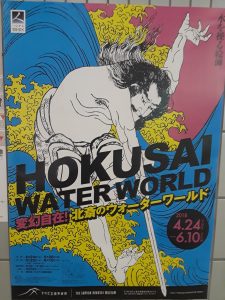
Of the activities we had this week, my favorite had to be the visit to the Edo Tokyo Museum. For one I am a huge fan of Edo art, and while it wasn’t really an art museum, I enjoyed what art I found there. Especially interesting to me was the art at the border of the Edo and Meiji eras, as it has a fascinating mix of Western and Japanese culture. I also enjoyed the museum’s structure as it does a great job of walking you through Japanese history chronologically. The artifacts presented did a great job informing the overarching historical narrative and the various homes presented showed the changing nature of family life. It was a great museum and if I get the opportunity I’d love to go back again.
On a bit of a tangent, I had a conversation with an AJALT professor earlier this week that really informed my understanding of why Japan is so clean. Apparently when the Olympics first came to Japan during the postwar occupation, Japan had an advertising campaign to try to clean up Tokyo. This campaign was apparently so successful that many of the campaign’s ideas persisted into the modern era. In the Edo Tokyo Museum that I went to after that talk, I got to see the same history there but with the aforementioned advertisements. That was probably the highlight of the museum for me.
On the same day, we also went to see the Grand Sumo Tournament. All in all, Sumo was very different from what I expected. It felt like less of a sport and more a ritual. Between matches, we would typically wait 4-5 minutes while the sumo wrestlers would throw purifying salt on the stadium and make gestures to the crowd. The actual rounds were usually just 10 seconds long. Between the matches, employees would wave around the flags of the advertisers who were sponsoring each match. In retrospect, I think that coming in with a mindset that this would be like any other American sport kind of spoiled the experience for me. Now I can understand the extent to which it is based on ritual, but at the time I expected it to be faster paced.
Introduction to Science Seminars
The science lectures by Prof. Kono were helpful. I have been working in a quantum physics lab for the past year or so, but I hadn’t really covered the underlying science behind my research. While I’ve had some exposure from my modern physics class, that didn’t relate very much to what I was doing in research at Penn State. This lecture was a great bridge from the quantum physics I had been learning in class and the quantum physics I will be using in my research lab, so I am very thankful for those lectures.
Prof. Saito’s lecture was interesting. I like discussing the more mathematical side of quantum mechanics so this was my favorite of the series. Relating the theory to ongoing research projects was also something I enjoyed. Prof. Otsuji’s lecture was a nice contrast to Prof. Saito’s in that it covered the more experimental side of things. Graphene is a fantastic material and his lecture got me excited to work with it. These lectures were a great introduction to science research in general, but because of what they were themed around, I was able to develop a great understanding of the science behind my specific experiment. I’m extremely excited to get to my lab and start working now, as I have a much better understanding of the importance of my project.
For my specific project, I will be working with graphene, specifically in the form of nanoribbons. Graphene typically has a two-dimensional structure, but I may be pushing into the one-dimensional regime with this research. Most graphene ribbons up until now have had a characteristic width of around 10 nm, which is far from freezing out the second dimension, but I will be working with ones that can theoretically be as thin as 3 nm, so they are near the dimensional border. Graphene is a conductor, but in these nanoribbons it can actually function as a semiconductor and develop a band gap. This band gap and the accompanying electrical properties are the focus of my research project. I will be using an AFM and SEM for this project, which means I am likely analyzing nanoribbons that the lab fabricates. The biggest potential application for this research is logic electronics as a controllable band gap in such a highly conductive material could help scale down transistors.
Question of the Week
Earlier this week I was talking with one of the Japanese fellows at the Fuji Sengen Jinja about Hotoke. From my Japanese studies, I had thought that Hotoke was just the Japanese word for Buddha, but I was informed it could refer to other things as well. For instance, Hotoke apparently has an association with graveyards and the dead. So this week, my question is what is the concept of Hotoke and does it have any relation to Japanese history?
- This actually sounds like a great paper topic for any future Japanese history/culture course you may take as this is an example of how a word may have a surface/dictionary meaning but culturally may have much greater significances. Here are a few articles/resources I could find related to this topic that may be interesting for you to review.
Week 03: Noticing Similarities, Noticing Differences
Even after three weeks in Tokyo, I still struggle to understand train etiquette on the subway. After about a week here I thought it was a rule that you couldn’t eat on trains, but I eventually found someone breaking that eating a chocolate bar right next to me. Likewise, I thought chatting was supposed to be kept to a minimum, but one time I was heading back to Azabu Juban on a late-night train and most of the people in my section were talking. I’ve even seen Japanese people carry huge backpacks on their back rather than front like I’ve been told not to. The only rule I’ve come up with that has been upheld until now is no talking on your phone. Still, I expect that to get broken at some point too.
It seems though that most of these rule “violations” occur on emptier trains or when there are groups of younger passengers. So it feels to me as if train etiquette really depends on who you’re travelling with more than anything else. Like with most things in Japan, if you just do what the people around you are doing you shouldn’t run into any problems. In general, I think if you ask yourself why the various rules are put into place you should be able to understand when it is socially acceptable to violate them. For instance, the stairs in the subways have clearly labeled up and down arrows to avoid congestion during rush hour. If the stairs are crowded, then absolutely follow those rules. But if the stairs aren’t crowded, then there is no reason you need to follow the arrows, and you will see many Japanese people breaking the rules. The goal is to not stand out, and following that principle is really all you need to integrate into Japanese society well (although it is much easier said than done).
As for what people do on trains, I see a lot of people messaging with Line or playing smartphone games. Even the people standing will have something to do for the most part. It seems to me that people make very effective use of their time on trains, which makes sense since they spend a significant amount of their life in transit. Thankfully, my commute at Chiba University is just one stop so I’ll hardly be bored, but finding some phone games to play for longer trips might be a good idea.
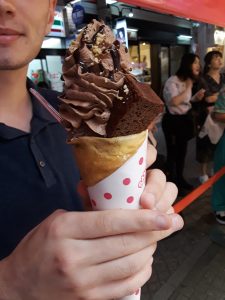
This week I had two free afternoons and two free days so I was able to get a lot of sightseeing done. On Monday, I went with Josh to Ikebukuro. We had heard there were a lot of anime related stores there so we wanted to check them out. Unfortunately, what we didn’t realize is that the anime goods sold at Ikebukuro are primarily intended for women, but we still had lots of fun sightseeing. Ikebukuro boasts Japan’s largest Pokemon store and a beautiful temple (Honryuji) close to the station so it was hardly a wasted visit.
On Saturday, I decided that I should try pachinko at least once while I’m in Japan, so I went to Akihabara with Josh to try it out. First, we had to work out how to get in. The pachinko parlor has jet-engine level noise so we had to go to go searching for earplugs before we could even enter. We ended up finding them at a nearby Family Mart but that took us a while. After getting in, we realized we had absolutely no clue what we were doing. We found an empty machine, but there were way more buttons than we expected. Unfortunately, it is nearly impossible to communicate inside the parlor due to the sound, so we only had hand gestures to work with. We put 1000 yen into the machine and it started firing metal balls up a ramp. After a while, the girl in the booth next to us asked if we needed any help. We learned that twisting the knob on the right side of the machine controls the speed that the balls are shot out with, which let us finally start playing. Once our first game finished, we had no clue whether we got a prize (or how we would collect it). We reconvened outside the pachinko parlor and found out that Josh had actually won his game. We had no way of claiming his prize though, sadly. But we tried again, and by some miracle we both ended up winning small prizes. Redeeming those would prove to be another challenge though as we had no way to communicate with the receptionist. Despite all of these issues I would still recommend everyone try pachinko at least once. Figuring out how to get in, play, and redeem our prizes was difficult for sure, but it was fun overcoming each new challenge.
This week, we had a variety of Japanese culture lecturers. Nishikawa-sensei’s presentation on Life Science was interesting, especially when he was talking about applications of genome data. It’s incredible to me that sites like Ancestry.com can be more than 99% accurate in tracing lineages. That aggregated medical data can be used as sources in scientific publications was also fascinating. I am very interested to see what we can do with human genome data in that future. Ozaki-sensei’s Japanese language presentation was quite useful. I’m at a level in Japanese where I can understand and use honorific language, but only in basic ways. Ozaki-sensei showed us several ways we can inject honorific language into more common phrases and I am excited to try those.
But of the Japanese culture lectures we had, the one I enjoyed the most was Ito-sensei’s. I found the history of the kimono interesting, but more than that, the kimono and its relation to nature is fascinating. Kimonos are made only from natural materials, so there is a huge variety of ways you can make them. One kimono he showed us was made from banana peels. Another was wooden. Even the dyes are only taken from nature. The painting process seems so elaborate and I’m awestruck by the fact that some of these would take several years to make. Thanks to Ito-sensei’s lecture I can really appreciate the beauty of this Japanese tradition.
My favorite part of his presentation though was the part where he talked about ephemeral beauty and how it tied the samurai and the cherry blossom together. Both have fleeting, but no doubt colorful lives. Ephemerality seems like a wonderful lens to interpret Japanese culture. In a land where catastrophic natural disaster can strike at any time, people have to live in the moment and lead beautiful lives. The Japanese ethic of only focusing on the task at hand feels like something born from this sentiment. Furthermore, no matter how many times Japan’s temples topple, they will almost always be rebuilt, and more beautiful than before. Even the more modern Japanese cities feel ephemeral, as their flickering lights become a sort of mirage as dusk fades to night. It’s no wonder that the subway system of Tokyo is one of the best in the world, as its ridiculous efficiency enables the rigorous Japanese lifestyle. Japan may be a land of tradition, but it feels as though creating beautiful moments is just as Japanese a value.
Up until now, my favorite moments with Japanese have all involved dealing with difficult situations. For instance, last week, when I was getting haircuts with some of fellows, Lincoln asked if I could tell his barber that he wanted a buzzcut. The barber did not understand the word buzzcut, so I had to get creative and tell him “Could you give him that American soldier haircut?” Likewise, when I was at the grocery store right before heading to pachinko, I had to ask whether they carried earplugs. The only word I knew at the time related to earplugs was “mimisen” which I think might refer just to headphones. So again, I had to get creative and describe what earplugs are while working around the word. Anyways, the Japanese language classes up until now have been useful. Rather than focusing on grammar, AJALT gave me a lot of specific vocab that will be handy for my research and a wealth of conversation practice. I appreciate this, as these are skills I will absolutely be using over the next 8 weeks. I’ve mentioned this earlier, but I think as long as I continue to practice kanji and speaking Japanese, I should be able to learn a lot from this program.
Introduction to Science Seminars
The science talks this week were useful. Prof. Stanton’s lectures were a great compliment to Prof. Kono’s and I feel I have a solid understanding of solid state physics now. Futaba-sensei’s lectures were interesting as they gave a more industry-oriented perspective on science. He had lots of funny stories as well! Finally, Ishioka-sensei’s lectures gave me a different perspective on research in Japan. It feels as if connections are extremely important for success here and Japan has its share of research problems.
As for my research project, it seems really straightforward now. After reading the rest of the Chiba University site in Japanese I learned a lot about experimental techniques the group uses and I feel I have a very good idea of my project.
Question of the Week
Is it common for restaurants to tell their regulars “see you tomorrow” (mata ashita)? I’ve been going to a pizza restaurant for just three days in a row, so it seems unusual for an employee to be telling this to me. Maybe he means it as a joke?
Return to Top
Week 04: First Week at Research Lab
So far, I have really enjoyed my time in my host lab. When I first got into Chiba station last week, the graduate student I’m working with, Kensuke Aoki, came out to meet me. He told me that since he shares the same last name as the professor in our lab calling him Ken would be fine. Right from the start we are only talking in Japanese, which is exactly what I wanted. After meeting at the station, we headed to my dorm to drop things off and then we’re off to the lab. I was given a tour of the facilities by the lab members and then we all headed out for lunch. I told them I was vegetarian in advance so we went to an Italian restaurant. I’m not sure if that was my orientation meal or not because the professor later asked me whether I can drink or not and if there were any Japanese foods I like. After that, we all headed back to the lab and Ken asked if it would be okay to do some SEM (Scanning Electron Microscope) practice on the first day. I of course agreed and we actually got through a full data collection run. It was a great first day as I got oriented to the lab and also learned the basics of the equipment I will be using.
My first week has been a mostly pleasant experience. I’ll talk about the bad things first just to get them out of the way though. On my second day I lost my dorm key, so I had to get that replaced. It was expensive, but I was impressed that the dorm staff directly delivered it to my lab. Also, I did not know that the washing machine on my dorm floor was broken, so when I got my clothes out they were still soaking wet and it would take around seven hours of drying before I could put those away. Everyone speaking Japanese has largely been a non-issue, except for the solid-state physics lectures that I attend once per week. I’m starting mid-way into a semester and I haven’t had any solid-state physics background not counting the Nakatani science lectures, so it’s been hard. Sometimes it’s difficult to tell whether it’s the physics or the Japanese or both that I’m struggling with for those. Luckily, a student in the group lent me an English version of the textbook that class uses so using that I’ve been able to make more sense of it.
Everything else has been fantastic. As expected, this lab has very few English speakers so I’m able to get a lot of Japanese practice here. Talking about experimental techniques in physics is fun and even though I have to ask a lot of questions sometimes, I’m able to understand what’s going on. The lab culture is a lot more casual than I expected, especially with respect to language. No one in the lab uses any honorifics except with the professor, which was a bit surprising. Anyways, Aoki-sensei helped sign me up for a Japanese kanji class which I’m sure will be helpful as well. When I showed up to the first day for that, I realized that I had selected a more beginner level class and the teacher was able to transfer me to a class properly at my level. I actually joined the class on the day of their midterm so the professor asked if I would like to take it for fun. I agreed and I think it went reasonably well considering I haven’t been taking the course. The international house I’m staying at is great and has all of the amenities you’d expect as well as a lot of extra things. There’s an AC, mini kitchen, mini fridge, closet, shower, toilet, and ethernet port all in my room. The only thing I miss really is having a trash can. I still haven’t worked out how I should dispose of trash, but that’s a problem for next week. In the meantime I’ve just been using garbage bags.

I’ve also been finding a lot in the way of the recreation. To my surprise, Pokémon is really popular in my lab and almost everyone plays the online trading card game. This is especially interesting as there is no Japanese version for that, so they play in English. I’ve already been asked questions about some of the English text on the cards so I’ve translated for them sometimes. Also, one person in the group had a poster in his lab area of an anime character from an obscure Japanese video game and the whole group was shocked that I was able to guess it right. They said they’d like to go with me to Akihabara sometime to see what else I can recognize. Anyways, the highlight for me this week was joining the university table tennis club. I had to do a lot of research to figure out how to join as their club page was only available in Japanese, but I went to their practice and found I really liked it. As with the lab, people only speak in Japanese there which is perfect for me. I realized that I had been playing table tennis almost entirely wrong and the first day was spent figuring out how to correctly swing at the ball. I got a lot of practice in and I am excited to actually start playing some games next week. Also, I had to purchase a table tennis racquet and I was guided by a club member to a table tennis store a few train stops away. What I didn’t realize at the time is that this was actually a high-end table tennis store where you buy a frame and then they apply the rubber themselves. I don’t want to talk about how much this cost me, but it was cool seeing the staff heat up the rubber, spread it over the racquet, and then use special scissors to clean it up. Well anyways, with that I shouldn’t have any problems playing now.
It seems there isn’t all that much to do in Chiba. I asked one of the members of the tennis club if there’s anything interesting here and he said that the food and the proximity to Tokyo are basically it. He is absolutely right about the food, that’s for sure. All of the ramen places I’ve been to so far have been incredible and much better than I’ve had in Tokyo. The donut place I went to was also fantastic, but I think that’s a chain so you can probably find it elsewhere. Next week I’m going to check to see if there is anything interesting to do in this area, but I’d be perfectly okay if it turns out there isn’t much. Chiba is really close to Tokyo which has just about anything I’d want to do. The trip is just about 1000 yen so it makes for great day trips.
Reflections on Orientation Program in Tokyo
The orientation program in Tokyo was very helpful. If I just started in my lab I probably would have no clue how to navigate the train system, get food, or really do anything. Knowing about the variety of services offered at convenient stores has also proven especially handy. Just living in Tokyo for three weeks was helpful on its own. But particularly useful to me were the science lectures. They complemented the modern physics I had and filled in the gaps I needed for solid-state physics research. The language classes were also useful as I learned a lot of the terminology that’s being used in solid-state physics lectures and explanations. It was much more directly applicable to my research than I had originally thought.
Still, I think the most important thing I got out of the orientation was self-awareness of some of my weaknesses. I really like to keep to schedules, and even though I think I am a fairly patient person, I’ve discovered that I have a hard time dealing with long wait times that throw my schedules out the window. In America it feels like there’s less to plan around, but maybe that’s just because I’m more used to the culture. Either way, becoming aware of this aspect of my personality has been useful and I feel like I have an easier time dealing with waiting now. Anyways, in the coming weeks I want to travel to more diverse places in Japan. I’ve already seen a lot, but it’s mostly been the big, modern areas of Tokyo. It would be nice to see the older places for contrast and to get a better idea of how Japan’s past is connected to the present. Chiba is a great place to travel from, so I have a lot of options.
Research Project Introduction
As for my research, that seems to be progressing smoothly. The group doesn’t seem quite sure what my specific project will be so I’ll be getting that on Monday. It will definitely be dealing with graphene nanoribbons as mentioned earlier, but how specifically I’m still not sure. So this week was mostly used to teach me the lab equipment I’ll need to use. In this first week I learned the basics of graphene as relevant to my research, had multiple SEM data collection runs as training, and used an atomic layer fabrication device. I know that the SEM is going to be vital to my project, so I’m glad I get to practice with it early. It seems complicated but I feel that with a few more runs I’ll have the hang of it. Resolving the resolution on the device with each zoom is actually a lot of fun. It reminds me of the tests an eye doctor would give you where you check whether the left or right image is more clear. Also, with SEM training came clean room training, which was certainly a first for me. You have to put on a lot of gear to enter a clean room and there are a lot of things to be cautious of while inside one. Entering the clean room is not straightforward and usually involves throwing some switches and taking an air shower before entering. The atomic layer fabrication device (I know that’s probably not the name, but that’s what it does) was a lot easier to work with than the SEM and I feel I already have a solid understanding of it. Next week I will be getting my research project and probably a timeline along with that so I should be able to give a more thorough update then. This week was still really useful though as a sort of orientation to what I’ll be doing in lab.
Question of the Week
I’m a bit confused as to what I’m supposed to do with my umbrella. My umbrella is too small to fit in the umbrella holders but it’s probably considered rude to bring it inside places so I’m really at a loss as to what to do. So what I’m wondering is whether it’s culturally acceptable to take my umbrella inside buildings, and if not, should I just buy a new one?
- Yes, you are correct, you should not bring a dripping wet umbrella into a building in Japan. You can either just put the wet umbrella on the floor next to the umbrella holder (as long as it will not fall and trip anyone) or you can just carry an empty plastic bag from the convenience store in your backpack and put your wet umbrella in that. For more, see the section on umbrellas on our Fashion in Japan section of the Life in Japan resources page.
Week 05: Cultural Analysis – Life in Japan
I’s like talk about some of my smaller interactions this week and what they inform me of both Japanese values and my own.
The first thing I’d like to talk about is an incident from the week before this actually. When I was going to buy tennis clothes at a mall (AEON), I needed to find a cashier, so I asked a couple nearby if they knew where that was. Despite them being clearly American, I accidentally initiated the conversation in Japanese. They told me they don’t speak Japanese and that if I ask in English they could help me: exactly as expected. It was a bit embarrassing, but it did inform me of one issue I have with Japanese culture, that being that it’s very hard to get me to switch languages. I seem to have a Japanese mode and an English mode and while I can use both I tend to choose without putting much thought into it. Over the rest of the summer, I think being more selective about when to use Japanese vs. English would be helpful, as there are times people want to hear English (as my next mini-story will show).
Sometimes I forget that while Nakatani RIES is a learning experience for me, it is also a learning experience for everyone interacting with me. Just as I’m coming to terms with Japanese values, the Japanese people I’m interacting with are learning about American ones. Earlier this week, someone in the table tennis club reached out to me and asked if I could speak English with him at the club. I asked him why and he told me that it’s very difficult to get English practice with native English speakers in Japan. After that interaction, a lot of things started to click for me. My research professor had been speaking in Japanese to the rest of the lab group but only in English to me. Up until that point I had been talking with him in Japanese and we’d been having a weird English / Japanese conversation system going. I realized then that my professor almost certainly wants English practice, so since I’ve been speaking to him just in English. It seems that no one else in the group wants the English practice, so I’m getting more than enough Japanese practice anyways. Speaking English could be a great way to make new friends in Japan, so if someone asks me I’d more than happy to.
I did have one relatively unusual incident this week. A few nights ago (I think Friday) I got a knock on my door. It turned out to be the person on the floor below me and he was complaining about some noise. I was very surprised as I have been largely silent in my dorm room bar the occasional skype call, and even that I keep at low volume. He started talking in English which was a bit difficult to understand, but thankfully he sensed my confusion and asked if I can speak Japanese. After switching languages I was able to get a much better sense of what was going on. He told me that on most nights at around 10 pm he had been hearing a crashing sound from my room. Thankfully, that was the extent of the complaint, but still I had no clue what was going on. What we eventually worked out is that I would add him on Line and when he heard the crash, he could message me and I could try to identify the source. We had a guess as to what it was though. I had been leaving my luggage bag on the floor and every time I need to get pajamas, I had been opening the side of it and resting it against a wall. My guess is that I had been opening this before showering and then it crashes down before I get out. It would also explain why I wasn’t hearing anything as I was in the shower. Since then I haven’t heard anything from him so I think I’ve solved the problem, but it’s possible I haven’t yet. Either way, I think the system we came up with should really come in handy should there still be an issue. After that I chatted with him a bit more and discovered that he was actually a physics major himself. Not only did we work out a makeshift solution to the problem, but I think we became friends as well. From this experience, I’ve learned that if you’re humble enough in Japanese culture, especially as a foreigner, you may really surprise the Japanese people you’re with. As with any culture, people will appreciate when you speak the language and you may even be able to mitigate damage like I was this week.
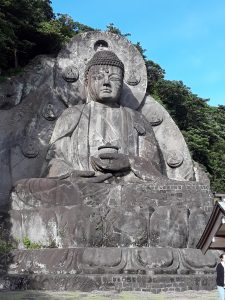
So now I’d like to briefly talk about some of the things I’ve seen and done in Japan this week, as this was one of my busier ones. In my Japanese kanji class, I met a student named Rashido from the UAE. He gave me some remarkable insight into Japanese culture so I have to include his story here. Apparently in the UAE, Japan scholarships aren’t in high demand so he told me that he was able to easily win a lot of them and that there were even a few that he was the only applicant for. He ended up going to Tokyo University for graduate school and he told me he has to pay very little out of pocket. The only catch is that for one of his scholarships, he is required to take one Japanese class per year, and Tokyo University won’t let him take any there as a graduate student for some reason. That is why he’s taking the same class as me at Chiba right now. He’s essentially fluent in Japanese (he’d been studying since high school), but he’s still required to take something, so he thought a kanji class might be a good idea as he could use the writing practice. Anyways, I asked him what it was like to be a graduate student in Japan. He told me first and foremost that he wouldn’t give this experience up for anything and that he’s having the time of his life. He says that he never really lost the feeling that he needs to see as much as he can and so he spends nearly every weekend seeing something interesting, as if each weekend was his last in Japan. Still, he did say there were some problems he had living in Japan. For one, he told me that racism is definitely a problem in Japan and that while people may be kind at a surface level, it can be difficult to form deep and meaningful relationships with Japanese people. He said that no matter how much Japanese practice you have, you will have to find a way to get past these differences, and usually a shared activity is the way to do that. So it seems that my decision to join the table tennis club was the right call. The other problematic thing for him was the lab hours he was expected to work. He said that they are not nearly as bad as some people make them out to be and that there’s a lot of flexibility with your time in lab (as I have been noticing myself), but that they really made it hard for him to maintain weekly activities. He’s a member of his university’s soccer club, and to participate in that he has to leave early 2 days a week. In exchange, he stays longer hours on the other days. He said that some days it can be draining, but that that might just be research in general. As I was leaving to get back to my lab he gave me one last piece of advice, that being that while Japanese girls might be cute, the ones he’s dated haven’t been “right in the head” and that I should be careful should I try to date someone. I was in a hurry so I didn’t get to ask him why, but I will definitely follow up as it feels like there will be interesting stories.
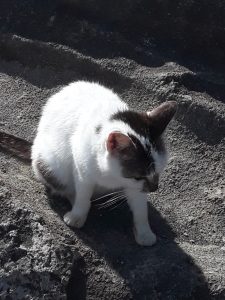
On Sunday I finally got to see the more natural part of Japan. I went to Hama-Kanaya to see the giant Buddha statue and on the way I saw rural Japan and a lot of beautiful coastline. I left from Inage station at around 1 and my trip ended up taking about 2 hours. From there, I had to walk for about 20 minutes to a ropeway that I would use to get to the top of the mountain where I could find the giant Buddha statue. I ended up arriving at 3:30 and the last ropeway was at 4:45 so I really had to hurry. What I didn’t realize is that this temple complex housed way more than just a giant Buddha statue and that there were things to see almost everywhere. For those of you who go to Chiba in the future, this is well worth making a day trip and I’m sure you could reasonably spend 3-4 hours here. Anyway, with my one and a half hours all I could manage was a frantic run around the complex taking photos of only the things that stood out. Still, I had a great experience.
Coming out of the ropeway, I found a stray cat that actually followed me for a while as I was exploring the first few areas. There were a lot of smaller statues of monks which were interesting, but what stood out were of course the two colossal Buddha statues. I was able to see both of them and the second, larger one really left an impression on me. I don’t think I’ve ever felt intimidated standing in the presence of a statue before so that was certainly a first for me. It’s very hard to get across just how overwhelming the aura that statue projects is without being there yourself. It was a remarkably spiritual experience and I think if there are any future Buddhists in the Nakatani program it would absolutely be worth the journey. I prayed before the statue while I was there too, so I think I managed to accomplish everything I wanted. On my way back, I had to climb what felt like an endless set of stairs. All the while, what I thought were monkeys were screeching in the nearby forest and I honestly felt kind of terrified. But I ended up making it safe and sound and just in time for that last ropeway. If I haven’t made it clear enough, this is for sure a place worth going to if you have any interest in Japanese buddhist traditions at all. This will probably be the highlight of my entire trip.
Research Project Update
As for my research project, it feels like it is much better defined than it was last week. Now I know for sure what I’m supposed to be doing and I’ve been able to make great leaps on it. My professor this week clarified with me that I am actually participating in two projects right now. The first is the one I mentioned last week where I am studying grain boundary electrical properties of graphene. This is meant to be a training project of sorts that gets me used to the SEM and other equipment that will be used in my second project, which is my Nakatani research objective. The goal of my second project, as previously mentioned, is to fabricate extremely thin graphene nanoribbons with widths well below 10 nm and report on their electrical properties. This week I learned how we would try to fabricate them. It seems that this particular method has never been attempted before, so I’ll ask my lab this week if it’s okay for me to explain the specific experimental technique in my next weekly report. That said, it seems like the idea they have could work. All I can say for now is that it involves silver nanowires. One of my images for this week is a sample that we have just prepared with these nanowires, and it looks stunning so I thought I had to include it. It really is one of the most beautiful images I’ve taken as part of research. All in all, things are going well and I’m really excited to see what will come of this project.

Week 06: Cultural Analysis – In the Lab
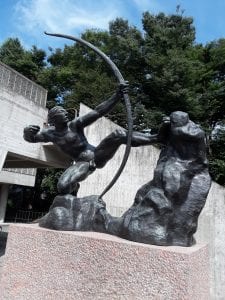
Up until now, I don’t think I’ve had any major misunderstandings in lab. I did have one relatively small one though that might make for a good story. So last Thursday, I finish up an experiment with the nanolayer fabricator at around 4pm. The graduate student who I’m working with (different from my mentor, we just happen to be using the machine at the same time) tells me that we have to wait on a depressurizing process for two hours and that I can leave if I want. In an effort to try to look committed I tell him that no, I can wait for two 2 hours. I head back to my desk and do some kanji reviews / physics readings until 6pm. He heads back into the room with me, hits a button, and then tells me “Okay, we’re done.” So I had essentially waited 2 hours for him to just press a button for me. If this story tells me anything, it’s that sometimes I need to be more assertive about asking for things. Sure I get by in the experiments well enough talking with my graduate student mentor, but sometimes I hesitate to ask basic things like “How long will this process take?” or “What do we have planned for today?” To preface that second question, it’s important to note that I come in and assist my mentor when he does his experiments and he helps me with mine so we pretty much do everything together. Anyway, being more proactive certainly couldn’t hurt.
Research Project Update
So this week I felt like I was able to operate a lot of the lab equipment fully on my own, My graduate student mentor was at every point watching me but he seldom had to say anything. This week I completed another fabrication process (For a CVD Graphene alignment marker), but by working more efficiently it only ended up taking 2 days. Working closely with my mentor, I also took AFM images of the silver nanowire / graphene sample and characterized their widths. This was very different from the AFM I have used back at Pennsylvania State University (PSU) and a lot older. Even though many of the steps remained the same, there were a lot of annoying parts that would just be automated on a newer device. For instance, I never realized how much of a blessing the auto-focus is on newer AFMs. On an older one, you would have to manually tune the voltage settings and adjust the current parameter so that it never exceeds a certain value. That whole process took us about 40 minutes but would probably take mere seconds on a newer device. All in all, I think it took us around an hour or so to get set up on the AFM here when it would take me around 5 minutes in the U.S. That’s not to say that all the equipment in the lab is ancient though. So far it feels like it’s just the AFM.
Finally, I fabricated 2 hall bars on the other CVD graphene sample. We had no issues with the fabrication and for once I had no trouble operating the SEM. As a reminder, my project is the silver nanowire one and the graduate student’s is the Hall Bar / graphene grain boundary voltage measurements, but we’re both working on both of them. For the second project, it seems that we have made great progress and will be able to set up the electrodes this coming week. For the first one, we’re a bit confused with the AFM images we received. The nanowires, at least according to the manufacturer, are supposed to have had a width of 20-30 nm (cylindrical), but it feels that under AFM they have a height of 30 nm and width of 60 nm. We took some relatively high-resolution images to so we’re sure it’s not an issue with AFM resolution.
Next week we will investigate the nanowires using SEM and see if we can’t get a better picture of what’s going on. If the nanowires are actually 60 nm they would probably be too wide to be usable and we’d have to order another sample, but I don’t think that will be the case. On the site that we purchased the nanowires from there was an image of a sample prepared using them, and under SEM they definitely looked like they were in the 20-30 nm range. We might also have aggregation of nanowires in our sample, but I think with what we have so far it’s difficult to say. All in all though, I think both projects are progressing well. Oh and there’s one last thing I’d like to mention. In the lab I’m in, we do weekly status updates on our projects through Powerpoint, which is great because it gives me practice presenting my research and also making Powerpoint slides. I’ve already had three of these presentations, and I think they were excellent practice and will also serve as excellent resources for the mid-program meeting presentations.
Life in Japan
Now as for less research-oriented things, I think I had my biggest challenge so far with Japanese this weekend. There is arcade game that I’ve been wanted to play in Japan that’s been having a pre-release event in Japan for the past week or so. In order to play it, my first challenge was finding the place. I had to go to the official website, which was in Japanese, and find the test location closest to me, which turned out to be in Akihabara. This wasn’t hard and I probably could’ve just used Google translate. After getting there, I had to reserve the ticket, which was a bit more challenging since you need to find the right people to talk to and the “ticket” is really just your spot in line. After that, I had to figure out how to get the line updates set up on my phone, as waiting in the arcade for 6 hours on the 200 people ahead of me did not sound fun. This was much harder, but I did finally manage to get SMS updates set up for the line.
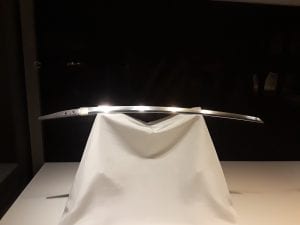
While I was waiting, I had four to five hours free so I decided to head to Ueno as I wanted to see the park and some of the museums. The park was as beautiful as I expected, but what was really surprising was the wildlife. There were a lot of ducks and birds there and the carp were huge. I even managed to see a few turtles, although I couldn’t get good photos. The pond there is huge, and had I had more time, I absolutely would have rented out one of the boats and spent the day doing that. Instead, I decided to go to the Tokyo National Museum. I only had 2 hours so I wasn’t able to see very much, but I think what I saw was interesting. Highlights for me included a sword forged by Muramasa (who is to sword-smithing what Shakespeare is to writing), a set of statues of Buddha and the Four Heavenly Kings, and a wood carving of a monkey that Japan put out at a world’s fair. If I had more time this would absolutely be worth making a day trip for. On my way out of the museum, I stopped by the western art museum and got a picture of a Hercules statue and a very well engraved door. All of these would be excellent for this weekly report, so it’s a shame I can only include three photos.
After that I headed back to Akihabara and finally got my turn at the arcade machine. It would be difficult to explain to someone who isn’t familiar with the series, but basically it was well, well worth the wait, even though I only got to play for thirty minutes. Of course, playing entirely in Japanese presented some challenges but I was able to read most of the important buttons / dialogue so I didn’t really have too many problems. Getting to do this was fun and a nice test of my Japanese skills up until this point.
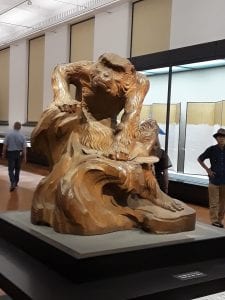
Another challenge that I had been working towards this week was table tennis. Before this week, I don’t think I was able to hit the ball at high speeds. By focusing on technique and getting a lot of practice in with games, I feel like I’ve made great strides and I can now play the game properly. Table tennis is fascinating from a mechanics / physics point of view as it’s not really about just hitting the ball with as much force as you can. Rather, it’s about controlling how the ball rotates so that it runs into as little or as much air resistance as you want, thus why learning proper technique is essential. I learned another way of hitting the ball this week called a “chop” that really put this in perspective. With this technique, you can slow down an incoming ball and have it gently float over to your opponent’s side. It’s a lot of fun to use as you have a large amount of freedom in where you want it to go, and if you’re playing a game where the ball has gotten too fast, this functions like a reset. But now I can properly play games with people and I got my first compliment (on my backhand) this week which was nice. I’m curious to see what I’ll be able to accomplish over the remaining 5 weeks now that I feel I have the basics down.
Question of the Week
At the art museum I went to I saw a lot of beautiful, probably upper-class goods which had me wondering, just how stratified was Japanese society? Was there a middle class and did they have any access at all to the fine art of their age? I know this is a pretty vague question as it spans lots of time periods, but it’s something I want to know for myself now.
Week 07-08: Overview of Mid-Program Meeting & Research Host Lab Visit
The Mid-Program meeting in Kyoto was great for sightseeing. The highlight for me was for sure the tea ceremony. Despite my feet hurting from the geta (wooden shoes) for most of it I enjoyed the experience immensely. The tea drinking ritual was not as difficult to perform as I had imagined and the snacks and tea were delicious. I do feel like for the tea making ritual we got a very simplified version taught to us. The instructor’s cleaning up of the tea implements was highly sophisticated and I doubt any of us could replicate it.
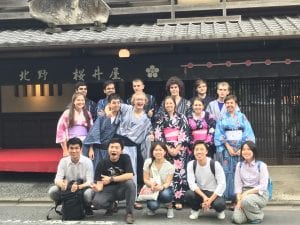
While I did find it kind of awkward, I liked wearing the yukata. I was happy with the pattern that I got (light blue) and I think it suits me well. If not for the shoes, this would actually be relatively comfortable to wear. I struggled to keep it on properly though and every few group photos or so I’d have to fix it up. The photo taking sessions with the yukata were fun as well. I’m not sure when would be appropriate to wear this in the US, but if I can find a chance I definitely will.
I also really enjoyed the Sysmex visit. Entering the building it became immediately apparent how they’re able to fund our program. The facilities were lavish and I’d love to be an employee there. Another Nakatani fellow described it as the Google of Japan and I feel that’s an apt description. There’s a meditation room, day care center, tennis court, gym, and just about any facility you’d want to use as an employee. It seemed abundantly clear to me that they care about their employees, although it did seem weird to me that none of these facilities were in use (especially the break room). The technology that they are working on for blood-based detection of diseases is interesting and I was able to follow that talk despite my lack of biology background. This would be an interesting company to work for and if I go to Japan for graduate school that could be an option afterwards to keep in mind.
Kyoto is extremely different from Chiba in a lot of ways. Unlike in Chiba, I never had to deal with strong winds there, but it feels a lot more hot and humid. I guess I never appreciated that until I lost it. Kyoto feels emptier than Tokyo which is nice for sightseeing because there are places to sit down and it’s easier to take nice photos. There are a lot less Western food options in Kyoto than in Chiba so that did make things a little hard for me with my diet, but I managed. I really liked the ramen that I got there though.
The hardest part of this trip for me was dealing with the cold I came down with towards the end of it. There were a lot of things that I wanted to see in Kyoto, but over the last two days I think I made the right call by heading back to the hotel and getting as much sleep as I could. This was a hard call for me because I wanted to see Kinkakuji and Ginkakuji temples, but I know what I did was probably right in the end. If I’d gone to the temples I probably would have been too miserable to properly enjoy what I was looking at. I still got a good amount of sightseeing done just travelling with the other Nakatani fellows though so I don’t feel bad about it.
This weekend I met up with a friend from the US and went back to Ueno for some more sightseeing. My friend is a photographer, so we were able to get some amazing photos that were way better than anything I’ve taken up to this point. Sadly, I won’t be able to get the photos until he gets back to the US, so I won’t be able to include them in this report. Anyway, we first went to the Tokyo Metropolitan Art Museum. I expected it to be an international art museum with lots of art across many different cultures, but it ended up just having French art. That’s not to say that I have anything against French art and what we saw was certainly remarkable; it was just surprising. There was one section of the museum where they labelled the different sections of Paris and arranged art by region. As I’ve had both French and Japanese, it was fun trying to match the katakana to the region names I can remember from French class. My favorite sections were probably the Monet paintings and paintings of cows. The Monet section shouldn’t require an explanation, but as for the cows, you’d be surprised how well French artists can paint them and that section of the museum was probably the highlight for me.
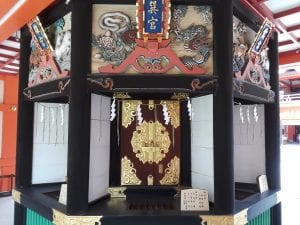
On Sunday I mostly spent the day in my room and I’m glad I did, as I haven’t gotten a chance to relax really since I’ve been in Japan. I did go see Chiba Shrine, but that was an hour long trip at most. When I went, I was surprised by how empty the city felt. My guess is that a lot of people just spend their weekends in Tokyo or in other parts of Japan. The shortest path to the shrine that Google recommended for me took me through some questionable streets with questionable merchants and that had me wondering whether I had mixed up the location. Nevertheless, I made it there just fine and as expected, the shrine was beautiful. There was a lot to see here but my favorite part was the donation boxes with zodiac signs they had. The animal designs were intricate and there were a lot of them to look at. As beautiful as the shrine was though, there was one thing I didn’t like. Sadly, the area in front of the shrine’s main building has become a parking space which really detracts from the appeal of it. There was only one car parked when I went there, but the advertisement I’ve attached should do a good job showing how ugly this can look. If they’re doing this to stay in operation I can understand, but that doesn’t change the fact that it really takes away from the beauty of it. I wouldn’t recommend making a trip to see this like for the Daibutsu, but if you’re seeing something else in the area this is probably worth stopping by too.
Research Project Presentation & Update
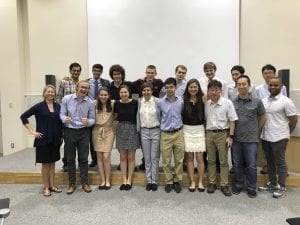
I believe my mid-program presentation went well, at least given the circumstances surrounding it. I was in a bit of an awkward situation for my presentation as the graduate student I was working with wanted me to include both of my projects while the professor wanted me to do just one. We ended up with a kind of weird compromise where I would do both but emphasize one over the other. I think I managed to explain both of my projects, but the presentation probably felt a bit rushed. Still, I don’t think it was a bad presentation. I think the graphics that I made for the fabrication process were useful as I’m sure that explaining that with just words would not have been effective. I hope the analogies I tried to use for various physical processes helped people with less physics background follow what was going on. Thankfully the poster at the end won’t have to be like this and I should be able to take my time explaining things.
Despite being back in lab for two days, I do feel that I have some results worth talking about. Just before I left for the mid-program meeting, we were struggling to come up with a method to fabricate the electrodes we need. When I came back to my lab, my mentor had an idea that we could immediately start testing out. By using photolithography, we can cleanly and accurately produce electrodes over nanowires, and we managed to do so twice. The first time we accidentally built the electrode over a gain boundary instead of a nanowire so it was unusable, but the second time we successfully built it around a silver nanowire. There are still a few steps left in the fabrication process, but I do not believe those will take long (gold deposition / lift off / O2 plasma bombardment). We should finally be getting our first results soon and I am excited to start analyzing them.
Question of the Week
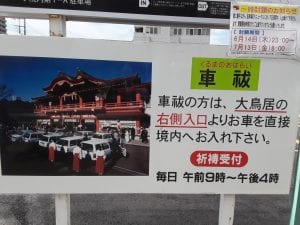
As a follow up to my discussion on shrines, I’m wondering if Japanese people take issue with how some of them have become commercialized. To me, when you start offering shrine-brand coffee and other souvenirs it starts to feel like a tourist shop rather than a place of worship. But maybe they need to do that to stay in business and people are used to it? It’s really hard to tell so I’ll probably need to ask people to get an answer to this.
- Keep in mind that people in Japan are, in general, not as religious as we are in the U.S. So, they may not have as strong feelings on this as someone in the U.S. might.
- Also, as tourists, we tend to want to and expect to see historic and religious places in their ‘unspoiled’ or ‘traditional’ light. When what we expect is juxtaposed with the reality of modern life, we tend to be unhappy. Kind of like how in every shot of the major tourist sites in Japan people try to get the ‘perfect’ photo that doesn’t show the throngs of other tourists surrounding you and the more commercial/mundane aspects like the long stalls of inexpensive or low-quality tourist souvenirs that often surround the more traditional areas. What the ‘tourist photo’ looks like vs. what the actual experience of visiting that location is like can be quite different.
- What to Expect When Traveling in Japan: Expectations vs. Reality (Tripzilla)
Week 09: Research in Japan vs. Research in the U.S.
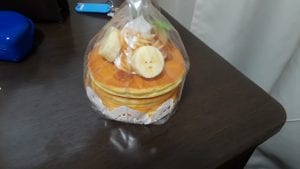
The lab I work in seems different from most Japanese labs (at least according to what I’ve heard so far), but I generally enjoy the work culture here. There are some aspects that I don’t like, but that’s true of research in America as well. Anyway, what I think I enjoy most about my lab here in Japan is the very clear divide between work and play. In the lab common area, it is acceptable to be playing games on your phone, watching sports matches, or just chatting with your lab mates. But when working with the fabrication equipment or performing experiments, everyone seems to be 100% focused on whatever they’re doing.
In American work culture, I think there’s an emphasis on making it look like you’re working when your superiors are watching, and that feels kind of fake to me. In my lab I feel that people are just as productive as their American counterparts but as there’s no need to keep up appearances, the lab culture feels healthier. Keep in mind though that I am comparing my lab culture to American work culture. In my lab in America it seems that people work much shorter hours than people here but are working 100% of the time. In that way I think I prefer the work culture in American labs to Japanese ones by a small margin. The American system feels more efficient and even though the lab culture here helps people network with each other better, there are sometimes days where I just want to get my work done and get out.
Compared to what I’ve heard about the standard Japanese lab though I think I’m happy with the one I ended up with. For one, the lab culture here is much less formal than I’ve heard it’s supposed to be like. People in my lab seldom use honorifics, which is great because it shortens the emotional distance between everyone. As I mentioned earlier, my lab doesn’t seem to care as much as some other labs about keeping up appearances, and I think that’s a plus. For one, people do not have to dress formally in my lab. I may have mentioned this in an earlier report, but I was surprised to find that just wearing a polo shirt, I was tied with the professor for best dressed in the lab. If you need to get food or a snack or anything you need you’re free to leave and come back to get it.
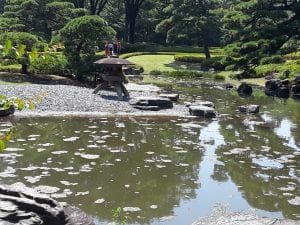
I think the lab culture here is very relaxed and that means the researchers here have a lot of freedom, which is good so long as you’re self-motivated. And even if you aren’t, the weekly meetings force people to stay on track to accomplish their projects. Aoki-sensei is hard on people who aren’t accomplishing what they need to get done, but that’s a given considering how much flexibility students in this lab are offered. That’s not to say that you have to produce results every week. There have been several instances where students have had presentations explaining how samples have gotten destroyed or damaged and the professor doesn’t seem to care. So long as you’re getting done what you need to get done, you should have no problem fitting in with this group.
And this leads me into my next point, which is that I think Japan does a much better job than America at treating science research like science. I’m no expert on the subject, but I believe that in America, oftentimes we put too much emphasis on getting publications and forget what science is truly about. As a graduate student in America, if you want a good job in academia or industry the more publications you churn out the better your odds. In some ways this is good as it encourages hard work, but it also encourages throwing out interesting experiments and being lazy in putting together new ones. In physics especially, oftentimes we get data that seems erroneous at first glance but might carry deeper meaning if you look more closely into it. Unfortunately, that’s exactly the sort of data that is becoming harder and harder to justify analyzing as usually the odds of it clarifying some new physical effect are slim. It is much easier to instead perform experiments that match theoretical predictions or lead to new interesting devices, as those tend to be easier to perform and get much better funding. What I feel we might be losing with the US approach is science for the sake of science or investigating something just out of curiosity.
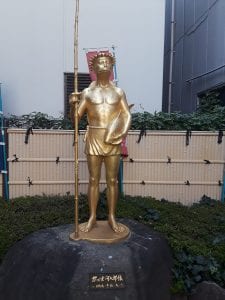
Now can I say that Japan doesn’t have the same problem? Probably not. I haven’t been in Japan in long enough to tell really. What I can say though is that what is incentivized in both cultures feels different. As a graduate student in Japan, I think you are less concerned about how many publications you are making and more concerned about getting your master’s degree in good standing. If I am correct in everything I’ve said so far, I feel that the research environment in Japan is much better for producing scientists than in America. Of course Japan still has a huge problem with people just going for master’s degrees and joining industry afterwards, but as for the work they do up until that point, I believe that much more closely resembles what science really is. Take away the monetary and status-based incentives and you get a lot more research that asks questions like, “can this technique work?” or, “what happens when we do this thing to that thing?”. Aoki-sensei really seems to echo that attitude as he never seems to care if a project fails; he only seems to care that students are working. All that said, while I have research experience in both Japan and the US now, I have not been a graduate student in either country obviously, so take everything I’ve said with a grain of salt.
This week my feet have been hurting a bit so I didn’t do too much over the weekend, but I did go see Kappabashi and the imperial palace. Both were excellent visits. Kappabashi was great for the fake food, but also for the statues of the kappa youkai that were all over the street. The kappa is one of my favorite youkai and seeing so many different depictions of it made me happy. I also got a fake plastic set of pancakes to take back with me to America. If you remove the top pancake, it comes off like a lid and you can actually store things inside the stack. The imperial palace was great too. I came primarily to see the Edo Castle Ruins, but I ended up disappointed with those. The most exciting thing there was the set of stairs near the entrance. On the other hand though, the garden was much better than I expected and made the entire visit worth it. It was such a beautiful place, and if it hadn’t been so hot I would’ve stayed there a few hours. Next week I’ll try to do a bit more if I can though
Research Project Update
As for my project, it seems to be progressing smoothly. We’re at the stage where we’re taking off the silver nanowires and after that we’ll be ready to start doing electrical measurements of our sample. We did attempt to remove a silver nanowire using a technique that I’m not supposed to talk about for confidential reasons, but that failed and ended up taking off the entire electrode instead. Thankfully we have another sample to work with still, as well as several different methods to experiment with. The next technique we aim to try should only take a few hours at most, so we should be getting results soon if all goes well. This has gone a little longer than I’ve expected, but regardless things seem on track.
Question of the Week
I’ve been playing some games in Japanese and I’ve been wondering why characters will refer to their own name with kana and use kanji for other peoples. It might be a way of including honorifics in dialogue, but I’m not sure, so I’ll definitely be asking my mentor tomorrow.
Week 10: Reflections on Japanese Language Learning
I’m not entirely sure to what extent, but I feel like my Japanese has improved through participating in the Nakatani program. The most notable improvement for me has been in speaking. At the start of the program, I think I was fine with my spoken Japanese from a technical standpoint, but I wasn’t necessarily choosing the most correct words to get across what I wanted to say. While the people I’m talking with were able to get what I was talking about, I’m sure some of these little mistakes told them I still have some ways to go. In part thanks to my conversations in lab, I think I have a much better handle on wording things correctly and my Japanese feels less awkward.
Also, I’m finding that there are tasks I can accomplish with Japanese that I’d never fathom I’d be able to do three months ago. Even though it’s still a little awkward, I can now talk about my research in my weekly presentations in Japanese. Sometimes I have to work around words, like last week when I replaced “oxidized” with “melted” when I was talking about nitric acid, but I’m gradually starting to incorporate the technical vocabulary into my speech.
As I’ve mentioned in my earlier reports, I haven’t had many communication issues using Japanese and the issues that have occurred have mostly been cultural (like forgetting to take shoes off or not putting an umbrella down). The hardest Japanese I’ve had to deal with has been in my physics lectures and video games. Once a week, I meet with Aoki-sensei and a few other fourth year undergraduate students for solid state physics lectures. These are challenging both from a Japanese standpoint and from a physics standpoint, as I haven’t had quantum mechanics or solid-state physics yet. Still, depending on the topic I may or may not be able to follow along. There was one talk he gave where he proved electron shielding from Maxwell’s equations that I was able to follow really well thanks to the high-level electromagnetism I took at Penn State. Other times the talk will have subjects like fermi energy levels where I have no clue what’s going on, even if the Japanese is relatively straightforward. Still, taking physics lectures on new material in Japanese is something I never would have expected I’d be doing 3 months ago. The other area I’ve been pushing myself in Japanese is with video games. Just before starting the Nakatani program I tried playing video games in Japanese, but I found they were a bit beyond me and that I needed some more kanji practice (because it’s not fun to have to pull out the dictionary at every new sentence). But thanks to my kanji class and daily kanji reviews I think I’m finally at a level where I can read game text at a reasonable pace. Sure, I still have to pull a dictionary out every now and then, but that’s become infrequent enough that it doesn’t hurt my enjoyment.
I could make an entire post about Japanese study resources now that I think I know what’s best, but I’ll try to keep this brief. Absolutely the most effective resource for learning Japanese is this website called Wanikani. It teaches Japanese at a very fast rate and covers everything that you need to learn (Kanji, radicals, and vocab) to read at a high level. Of course you will need some other resource for grammar, but this software is amazing for filling in gaps that Japanese courses typically have with vocabulary. It’s entirely feasible that using this software and a grammar textbook you could reach an N1 level of proficiency of Japanese in just a 2-year span. My biggest regret with Japanese is not starting using this sooner. I think if I had started a year earlier, I’d probably have no problem understanding written Japanese now and no issue following any of the physics lectures in my lab. It does cost a lot of money (about $200), but considering you use it every day for about an hour it’s an incredible investment in the long run.
Reading is another thing I’d really recommend doing once you know around 500 kanji and 3000 words or so. I’ve found that the most effective works are ones you where you can get about 80% of what you read. If it’s too easy or hard you’ll be getting nothing out of it. 80% feels perfect to me because you generally know what’s going on and when you don’t know a word, you should be able to find out what it means through context. Learning through context is a lot nicer than learning through a dictionary in my opinion, as you’re learning like a native speaker would.
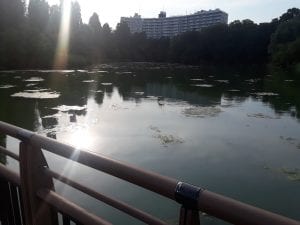
As for spoken Japanese, recording yourself is probably one of the best ways to get better. I didn’t realize while I was taking it, but I think the recording exercises in my Japanese class were really helpful in improving my Japanese. The teacher required that we self-assess our performance against native recordings, which forces us to catch on to small mistakes in pronunciation. Speaking Japanese is helpful too, but more for catching onto slang than for pronunciation or other things. Anyway, I’m excited to head back to the US now and see just how much my Japanese has improved.
This week I went to see Inokashira Park and I thought I’d talk about that a bit. It’s a lot smaller than Ueno park and there aren’t any museums or other attractions nearby (besides the zoo), so naturally there aren’t as many people there. It has a beautiful pond and a lot of musicians stop by the area (I even ran into a harpist there!). If you’re in Tokyo and are looking for a place to unwind on a cool day, it’s absolutely worth checking out.
Research Project Update
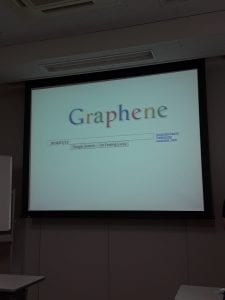
Research last week was kind of slow as we had to wait until Aoki-sensei got back from his trip to figure out how to deal with nitric acid waste. In the meantime, I fabricated three new samples that we can use as backups in case the nitric acid ends up not working. I still think I’m on track to produce results, and that those will probably be coming this week, but things are going a little slower than expected. It doesn’t seem it’ll pose too much of a problem for preparing the poster though.
Question of the Week
When Japanese people are learning kanji, do they associate images and stories with them like American learners do, or do they just rote memorize them?
- You might want to go to a book store and look at some of the children’s books for learning Japanese. I think by looking through these you’d get a better sense of how Japanese children begin to learn to read and write.
Week 11: Interview with Japanese Researcher
This week I interviewed a graduate (my mentor) and a doctoral student from the Aoki lab. I was really surprised by some of their answers to my questions and so I’m very excited to share them with you. I interviewed them both at the same time, so I got to see different perspectives for some of my questions.
I first asked them about why they were interested in materials science. The graduate student joked that he ended up because of his entrance exams, but after pressing him on it a bit he explained in detail. In his case, his interest in science started with physics. He eventually realized that he was more specifically interested in making new things, and almost veered into engineering before deciding on materials science. The doctoral student was kind of the same way, but his interest started earlier and he was fairly sure he wanted to go down that track from the start.
After that I asked them about what they thought about international research. Neither of them had any experience working abroad, so I first asked them generally what they thought about it. Both of them said that the experience is valuable, but more importantly, that you get to establish international connections, which can be difficult to come by in Japan. Both of them agreed that it would be useful in broadening perspective as well, but that the connections seem to be much more important. While it isn’t very hard to get involved in a research collaboration in Japan, it’s apparently very difficult to go abroad.
After that, I asked them what they thought was necessary to get into graduate school. Both of them immediately responded that grades were the most important factor, and stressed that they were much more important than anything else. I think the graduate student said that without a GPA around 3.7, your chances are slim. This is about what I expected to hear, but what came next was a lot more interesting. The doctoral student explained that to succeed in graduate school, you need to have good logical thinking skills. While doing well in classes is important, he stressed that logical thinking is the primary skill that you need to succeed in research specifically. This seems especially true in materials science research, where you use a lot of different devices. Being able to follow all of the directions for those is crucial to producing successful samples, and more generally, being a successful scientist. The graduate student gave a slightly different answer to this question and said that it is important your interests and the lab’s goals align. Especially in materials science, it is important you enjoy the specific material you are studying as it is very common you’ll only get to work with just that. He said that to succeed in research, it is vital that you first enjoy it.
Finally, I asked both of them about their plans after graduate school. The graduate student told me that he plans to go into industry, and that that’s very common in Japan. Apparently around 80% of students go until a master’s degree and then go right into industry. One of the main reasons for this is that companies giving hiring preference to master’s degree students over doctoral students. It’s the same as in the U.S., but apparently Japan has a larger problem with it. The doctoral student told me that this situation is changing though and that companies are gradually starting to give preference to PhD holding individuals. The situation still seems kind of bad though, for a few reasons. As the doctoral student explained to me, starting salaries for master’s degree holders are not much higher than those with just high school level education. Japan may be advanced in several aspects (especially healthcare), but overall wages seem to be on the low side. There also seems to be a weird trend where companies are gradually decreasing salaries over time. In some ways this is nice though as it’s changing the job climate for the better. People are becoming less tied to their jobs and switching jobs around is becoming more common. Although one tradition that might be holding that back is the way job hunting works in Japan. Since everyone looks for jobs at around the same time in Japan, quitting can mean being unemployed for several months if you’re not careful.
Lastly I asked a more personal question about life in Japan. If figures, anime, and mobile games are so expensive, how do Japanese people manage to buy them, especially considering the low average salary? The answer I got is that people generally cut down on life expenses (like food or alcohol) to save for things they want. It’s apparently extremely expensive to have as a hobby and most of the collectors who are willing to shell out thousands of dollars are rich people.
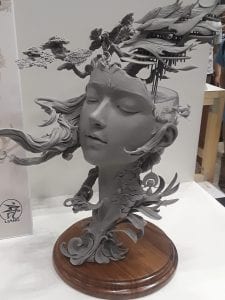
This week hasn’t been great for research. I feel like I’m very close to getting done with my project but I’m really being held back by device availability and issues outside of my control. Even if I’m not able to get the conductance data I want I still feel like I could make a fine poster, but it would nice to get the data and complete the project. Other than that, things seem to be progressing okay. At the very least, all of these delays have been useful in helping me get work done and study for my Kanji class final.
This week, I went to see Won Fes, which is apparently the world’s largest figure festival. I took over 300 photos there and had a great time. It’s definitely worth seeing for people in the Tokyo/Chiba area if you have any sort of interest in anime. There was a part of the figure festival where they had figures on display from various high school clubs, and I’ve got to say, some of them looked as impressive as some of the official ones. Thinking about that, I’m wondering whether making figures is something I’d be interested in trying when I get back to the U.S. I have no clue what I’d need or how to get started, but it seems like it might be a fun hobby.
Return to Top
Week 12-13: Final Week at Research Lab & Re-Entry Program
Overall, I’m very happy with how my research project turned out. Going into that last week, I had doubts as to whether I’d be able to get the data I wanted due to equipment availability, but I just barely managed to get the data in time. With that I confirmed that we are able to fabricate graphene nanoribbons at a width specified by the silver nanowire thickness, confirming the experimental procedure works.
In the future, I will not be able to assist with this project, but there are plans to continue on with it to a certain extent. My mentor Aoki Kensuke, wants to confirm the size of the band gap of the silver nanoribbon we fabricated and examine its thermal properties. He plans on presenting the data at some point if the band gap and thermal data falls in line with what he expects. Besides that, it may be interesting to combine this experimental technique with a thinner nanowire to see if thin graphene nanoribbons can be fabricated. I don’t know whether the Aoki group will attempt that though.
Once I get back to my lab in the USA, I plan to make use of the experimental techniques I’ve learned here in my own research. After talking with my research mentor at Penn State, it seems that I will be able to use the SEM skills I learned in a new project in my solid-state physics research. Furthermore, I believe that the intro solid state physics I learned from both my classes in Japan and the first three weeks of the program will come in handy in my research as well. Prior to participating in the Nakatani program, I only knew solid state physics well enough to understand my own research at a basic level. With what I know, I’ll probably be able to make sense of my lab’s weekly group meetings and the other projects that are going on.
Now going back a bit, my last weekend in Japan was hectic. I wasn’t able to get the data I wanted until the last Friday of the last week we had in Japan. This meant that I had to spend much of Friday interpreting my results and fixing up my PowerPoint. After finishing that up, I still had work to do on Saturday confirming my presentation with my host professor and packing for my trip back to Tokyo. By the time I got finished with all that, it was late Saturday night so I decided to make my return trip to Tokyo the following day. On my way back, I got my brother some souvenirs in Akihabara as I still hadn’t gotten him anything. I did miss out on the Fuji trip, but I was generally happy with how this last weekend turned out. While our lab had no closing party or dinner, I got farewell presents for the entire lab and I think they were well received.
I definitely experienced personal growth over the course of my Nakatani RIES experience. One major way this program has changed me is that I now find myself much more wanting to help strangers. Almost every time I asked a stranger for help in Japan, they would go above and beyond what I expected to assist me. I think that is a great way of being and I want to strive to do that for other people who might need help back in the USA. I also think I’ve become much more open to new experiences thanks to this trip. I look forward to participating in other similar programs in the future that might push me outside my comfort zone.
My perceptions towards both the U.S. and Japan shifted a bit over this experience. I came into this program expecting Japan to be vastly different from the United States, and yet most of what I discovered over this trip were similarities. Perhaps this was thanks to my grasp of Japanese, but regardless, I didn’t find my cultural things that I couldn’t understand while I was there. However, I think my perception of the U.S. and its culture may have shifted a bit. On my trip back to the United States, I noticed that particularly in the service industry, people value speed and efficiency. It may come off as a bit rude sometimes, but it’s something I can understand nonetheless. While I didn’t notice many differences between America and Japan at a surface level, they absolutely are there if you look a bit deeper into attitudes and what people value.
Coming back to the USA, there’s a lot I think I’m going to miss about Japan. At the top of my list is bakeries, as Japan has so many of them and they’re all so good. I’ll particularly miss melon bread, although I’m sure there are ways I can procure that in the United States. I’ll certainly miss working with my lab as well. It was a great work environment and from what I can understand it was abnormal even among Japanese research labs. The constant exposure to Japanese everywhere is something I’ll miss too. As a Japanese major, the more exposure I can get the better. It might be a good idea to get involved with some Japanese association at my university. On the flip side, I definitely won’t be missing the insects or the weather. Locusts are terrifying and I’m glad I won’t be seeing them back in the U.S. Besides that, I appreciate the freedom to eat or drink food wherever I want back in the United States. It’s a huge convenience. Most of my frustrations are just little things like these. Generally, I really enjoyed my time in Japan and it’s done a lot to sell me on potentially doing my graduate studies there.
The Nakatani RIES program has been eye opening to me in a variety of ways. It’s definitely shown me that doing research and potentially getting employed in Japan are possibilities worth considering. I have mixed feelings on the research portion though, or more specifically, materials science research. My research area for the program, materials science, was quite different from the physics research I was used to. On one hand, fabrication is extremely fun and perhaps the high point of the research I’ve done so far. Learning by trial and error with a very definite goal gamifies the experience and makes it quite fun. However, having to wait on devices is something that’s unavoidable with this type of research. Furthermore, working with so many different and dangerous devices meant that I never really could do anything on my own. This would obviously be a moot point if I did materials science for graduate school, but regardless I feel it has a pretty steep learning curve. It may or may not be something I do over physics research in graduate school, as I’m not sure which interest will win out. But in that sense I guess it was useful in showing me that is an option.
What I got out of the experience really depends on who I’m talking to. To my family, Nakatani RIES taught me how to truly live independently and adapt to new environments. To a professor, I’d say that the program taught me about a new field of research and did wonders to improve my Japanese. To an employer, I’d say that the experience taught me how to collaborate internationally across a variety of barriers. To a fellow student in my university, I’d tell them that it was fun, and an experience I’ll never forget. When I get back to the USA, I plan to study Japanese with even more fervor than before and continue my research at PSU so that the door to graduate school in Japan is left wide open should I choose that route.
Final Research Overview and Poster
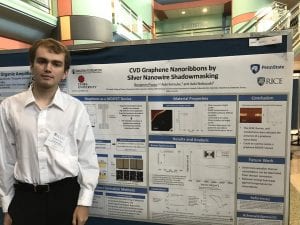
My final two research presentations went well I think. For the presentation at the Nakatani Foundation, I should have spent some more time preparing the slides. On the other hand though, the Japanese that I spoke during the presentation was fairly improvised and turned out great. Thanks to all of my weekly research presentations in lab I think I’ve become much better at presenting research and going off script when I want to. As for the SCI presentation, I think that didn’t have any problems. It was surprisingly easy to talk about my research and more fun than I expected. After presenting my research, I went to see some of the graduate poster talks. Many of the ones I found myself interested in were in non-physics fields, but even then, the presenters were able to explain things clearly and help me make sense of the research. They didn’t waste any time in getting to the main points and the presentations were well polished. If I end up in graduate school for physics, this would be a skill worth honing.
Research Project Abstract & Poster: CVD Graphene Nanoribbons by Silver Nanowire Shadowmasking (PDF)
Host Lab in Japan: Chiba University – Division of Nanomaterial Science, Aoki Laboratory
Host Professor: Prof. Nobuyuki Aoki
Introduction: The aim of this project is to determine if CVD graphene nanoribbons are a plausible candidate for FET (Field-effect Transistor) devices through investigating a novel fabrication technique.
Big Picture: Owing to its remarkably high mobility, a CVD graphene FET would boast better performance and energy efficiency than any conventional transistor device. It is possible that other experimenters may be able to utilize this technique to revolutionize transistor technologies, and consequently computing.
Approach: By fabricating graphene in nanoribbon structures, a band gap is induced that is inversely proportional to nanoribbon width. Using photo-lithography and thin film deposition techniques, gold electrodes are built over thirty nanometer diameter silver nanowires on CVD graphene. Silver nanowires provide a shadowmask for CVD graphene from oxygen plasma etching and are subsequently removed via nitric acid treatment, leaving CVD graphene nanoribbons.
Results: The results took the form of AFM, Raman, and Conductance data.
Analysis: The Raman spectra data indicates CVD graphene. The Conductance data provides evidence of a density of states type effect only possible in graphene nanoribbons. The AFM data confirms that the width is approximately equal to the width of the nanowire used in the procedure. All of this is to say that we confirmed the CVD graphene nanoribbon.
Future Research: The next step would be to combine this technique with thinner nanowires and investigate whether ultra-thin nanoribbons can be fabricated. If so, then incorporation of those into a MOSFET device would be the next step.
Follow-on Project
I plan on talking about the Nakatani RIES experience at one of the first-year seminars for physics students. I know the teacher for that class well as he’s my advisor and we already determined this would work. I’ll be talking about physics and how with Japanese it eventually led me to the Nakatani RIES program.
Tips for Future Participants
Pre-departure Tips
- I don’t have much to say for pre-departure tips as I think the Nakatani resources were very thorough with that.
- As you’ll see later in the language study tips, I think that using a service like Wanikani to memorize basic kanji once you have hiragana and katakana memorized would do a lot to help you understand what you’re seeing in Japan. Even without grammar, just knowing a lot of kanji vocab will work wonders in helping you get by in Japan.
Preparing for Research and Summer in Japan
- The best way to prepare for research abroad is by doing research yourself. See if you can’t get involved in some kind of lab if you aren’t already.
- For souvenirs, a good place to check would be your university’s store if it has one. University related merchandise is a fairly safe bet for souvenirs in Japan.
- As for food, if you’re a vegetarian like me it’s going to be hard. As soon as you get to your host lab, it would be a good idea to spend an evening or two walking around and checking your options.
- Lastly, sightseeing is a lot easier if you plan it out in advance. Before you head to Japan, try to use Google Maps and other resources to plan out what you want to see. That way you can spend more time exploring and less time planning while in Japan.
Orientation Program Tips
- You need to find a good balance between sleep and sightseeing. I’m sure some people have said it’s important to get a lot of sleep over these first few weeks, but for many applicants this will be their only time in Tokyo and there’s a lot of interesting things to see here. Try to find a balance you’re comfortable with.
- Further, do what you can to study kanji over these weeks as that will really help you get around Japan.
Mid-Program Meeting Tips
- I got a bad cold during the mid-program meeting and couldn’t see a lot of things I wanted to in Kyoto. I hope this doesn’t happen to anyone else, because there’s so much to see there.
- If you’re not in the Kyoto/Osaka area, definitely use this opportunity to see what you can. The scheduled programming was fantastic though and did make up for me not being able to see much.
Working With your Research Lab
- In terms of work, I had no issues with my research lab. I was able to understand what I needed to get done and got it done. I wish I had made more of an effort to integrate into the lab group though.
- All the people there are really fun and I was able to hang out with them a lot, but I should have used more of the downtime I had waiting on devices and processes to talk to people.
- As for my lab specifically, it would have helped to know that it was super casual. I ended up sending these almost excessively polite emails to my host professor and mentor before finding that out, and it created a bit of distance at the start.
Living in your Research Host City
- Inage is an amazing town and I was very happy with it. It’s only 5 minutes to the university by train if you ever feel rushed. Biking and walking there are still easy though.
- The Chuo-sobu line is amazing and gets you through almost every sightseeing place you’d want to see in Tokyo straight from Inage, making it really easy to plan out trips.
- While Tokyo was in the 90s or even 100s of degrees during the summer, Inage usually stayed around 80. You shouldn’t need anything for the weather, but a small towel or something would be worth carrying around just in case. Besides that, I don’t have much else.
Language Study Tips
- And here I have a lot to say. Knowing hiragana and katakana will help, but kanji and related vocab will work wonders in your ability to navigate through Japan, even without any grammar. I can’t stress this enough. It’s a big part of why I think my experience went well.
- There are several resources out there for studying kanji, but Wanikani stands out as the best one to me. It’s a bit expensive though, so if you don’t feel like shelling out the cash for that you have cheaper options with software like Anki. Wanikani streamlines the whole experience of learning kanji and vocabulary though and is worth it just for that.
- Also, Nakatani fellows with intermediate/advanced Japanese background should try to learn the technical vocab in your field. It will make your research more fun and make you a more effective communicator in your lab group.
